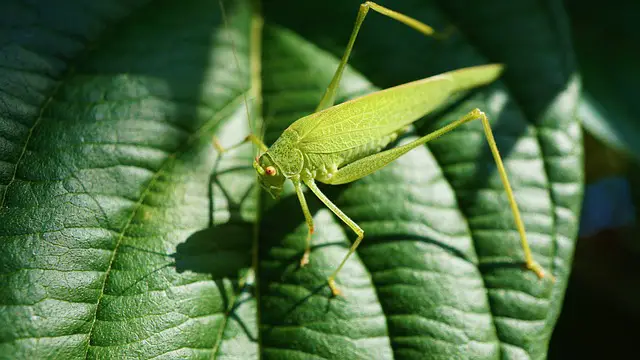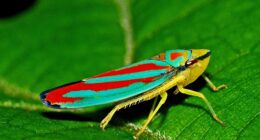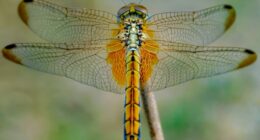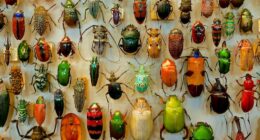Grasshoppers are solitary insects, while locusts are grasshoppers that form swarms due to environmental triggers.
TL;DR Grasshoppers Vs. Locusts
Grasshoppers are typically solitary insects known for their jumping ability and herbivorous diet. They have short antennae and don’t usually pose a significant threat to crops or vegetation. Grasshopper populations remain stable and don’t exhibit swarming behavior.
Locusts, are a type of grasshopper that undergo a transformation when triggered by environmental conditions such as overcrowding and food scarcity. They then form massive swarms, becoming highly destructive pests. Locusts have longer antennae, are highly mobile, and can devastate crops and vegetation in their swarming phase. This swarming behavior sets them apart from regular grasshoppers.
What are Grasshoppers?
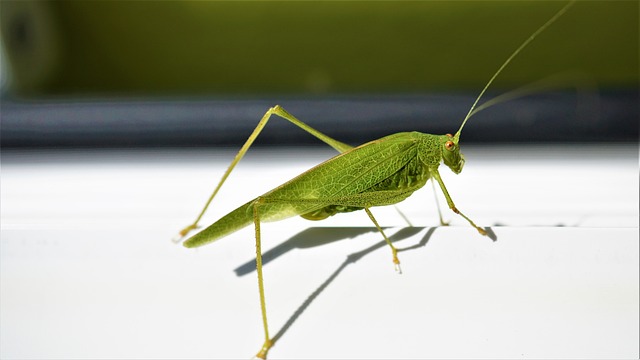
Grasshoppers are insects belonging to the order Orthoptera. They are characterized by their long hind legs, which are adapted for jumping, and their well-developed wings.
Grasshoppers are typically found in a variety of habitats worldwide and are known for their ability to produce a characteristic “chirping” sound.
They are herbivorous insects and play an important role in ecosystems as both predators and prey.
1. Physical Characteristics of Grasshoppers
- Grasshoppers possess distinctive physical characteristics. They have a slender body with long legs, antennae, and wings.
- Measuring between 1 to 7 centimeters in length, grasshoppers showcase a range of sizes.
- These fascinating insects have a pair of large compound eyes that grant them excellent vision. Additionally, they possess three small simple eyes known as ocelli on the top of their head.
- With regard to their wings, grasshoppers have two pairs. The front wings, called tegmina, are thick and leathery, while the hind wings are larger and primarily used for flying.
- One striking feature of grasshoppers is their ability to blend into their surroundings due to their varied body color. They can be green, brown, yellow, or black.
- The hind legs of grasshoppers are extremely powerful and specially designed for jumping. This enables them to cover impressive distances when propelling themselves.
- For feeding on plants, grasshoppers are equipped with chewing mouthparts that include sharp mandibles.
- As part of their life cycle, grasshoppers undergo incomplete metamorphosis. This process consists of three stages: egg, nymph, and adult. While the nymphs resemble the adults in many ways, they are smaller in size and do not possess wings.
- Male grasshoppers use a unique mechanism called stridulation to attract mates. By rubbing their hind legs or wings together, they create a buzzing or chirping sound that is distinctive to their species.
2. Habitat and Behavior of Grasshoppers
Grasshoppers are insects that are commonly found in grassy areas and open fields. Their habitat preferences include areas with plenty of vegetation for food and shelter. These herbivores feed on various types of plants, including grasses, leaves, and crops. They have a high reproductive rate and can lay hundreds of eggs in a single season, contributing to their population growth.
In terms of behavior, grasshoppers are most active during the day, especially in warm weather. They are known for their strong jumping ability, which allows them to move quickly and escape from predators. Additionally, grasshoppers produce distinctive chirping sounds by rubbing their wings or legs together. This behavior is primarily associated with courtship or territorial displays.
One noteworthy aspect of grasshoppers is their ability to undergo molting, shedding their exoskeletons in order to grow larger. This process is essential to their life cycle, with several molts occurring before they reach adulthood.
Understanding the habitat and behavior of grasshoppers is crucial for managing their populations, particularly in agricultural areas where they can cause significant damage to crops. To effectively control grasshoppers, it is important to preserve natural predators, such as birds and spiders, which play a role in regulating grasshopper populations.
Integrated pest management techniques, including crop rotation and early detection of infestations, can also help minimize their impact on agriculture. Regular monitoring and timely intervention are key in mitigating potential damage caused by grasshoppers and maintaining the overall health of ecosystems.
What are Locusts?
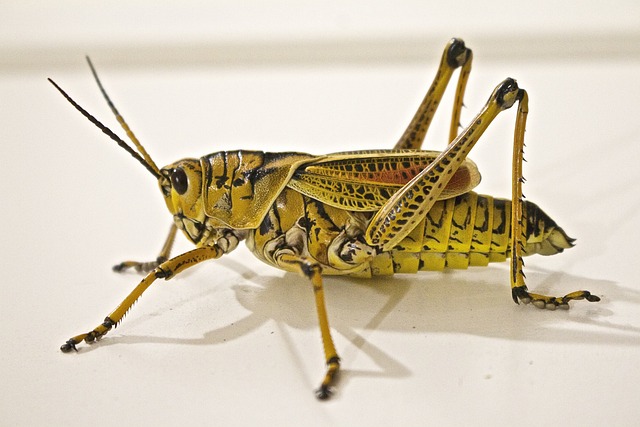
Locusts are a specific type of grasshopper that have the ability to undergo a striking transformation in behavior and appearance under certain conditions.
Locusts belong to the family Acrididae and are known for their ability to form swarms and migrate over long distances. These swarms can consist of millions of individuals and have devastating effects on crops and vegetation.
1. Physical Characteristics of Locusts
- Locusts, larger than grasshoppers, measure around 2-3 inches in length.
- Locusts have a brown or yellow-brown coloration, aiding in their camouflage within their environment.
- Locusts possess long, narrow wings that extend beyond their body length, enabling them to fly long distances.
- Locusts have short antennae, which they use for sensing their surroundings and gathering information about food sources and potential threats.
- Locusts’ strong hind legs are adapted for jumping, allowing them to cover significant distances with each jump.
- Locusts have a body structure divided into three parts – head, thorax, and abdomen. Their mouthparts and compound eyes are located in the head.
2. Habitat and Behavior of Locusts
Locusts are known for their unique habitat and behavior that sets them apart from grasshoppers.
Habitat: Locusts are found in various regions across the globe, including parts of Africa, Asia, and Australia. They prefer dry arid regions where there is ample vegetation for them to feed on. They are often found in grasslands, savannas, and agricultural areas where they can find suitable food sources.
Behavior: Unlike grasshoppers, locusts have the ability to change their behavior and form swarms under certain conditions. When environmental cues such as overcrowding, depletion of food, and favorable weather conditions are met, locusts can undergo a physiological and behavioral transformation known as gregarization. This transformation triggers them to gather in large groups and form swarms, where they can travel long distances in search of food.
Locust swarms can be devastating to crops and vegetation, causing significant agricultural damage and economic consequences. Understanding the habitat and behavior of locusts is crucial in managing and mitigating the impact of these swarms.
Fact: Locust swarms are capable of traveling up to 150 kilometers per day, affecting large areas of agricultural land and posing a serious threat to food security.
Key Differences Between Grasshoppers and Locusts
When it comes to distinguishing between grasshoppers and locusts, there are key differences that set them apart. We’ll dive into these variations, exploring the morphology, behavior, and ecological dissimilarities. Get ready to uncover fascinating facts and unveil the decisive factors that differentiate these intriguing insects.
1. Morphological Differences
In order to comprehend the distinctions between grasshoppers and locusts, it is important to examine their physical characteristics. By comparing their morphology, we can identify several unique features.
| Grasshoppers | Locusts |
| 1. Smaller in size | 1. Larger in size |
| 2. Slender bodies | 2. Robust bodies |
| 3. Antennae are shorter than their body length | 3. Antennae are longer than their body length |
| 4. Hind legs are adapted for jumping | 4. Hind legs are stronger and built for sustained flying |
| 5. Wings, when present, are shorter than their body length | 5. Wings, when present, are longer than their body length |
These variations in morphology contribute to the distinguishable appearance and capabilities of grasshoppers and locusts. Grasshoppers are characterized by their smaller size, slender bodies, shorter antennae, and hind legs that are well-suited for jumping. On the other hand, locusts are larger in size, possess robust bodies, longer antennae, and stronger hind legs that enable sustained flight. When wings are present, locusts have longer wings compared to grasshoppers.
Understanding these morphological differences is crucial for differentiating between grasshoppers and locusts, as it aids in the study of their behaviors, habitats, and ecological impact.
2. Behavioral Differences
| Behavioral Differences | Grasshoppers | Locusts |
| Individual behavior | Grasshoppers exhibit distinct behavioral differences compared to locusts. | Locusts, on the other hand, can form enormous swarms containing millions of individuals. |
| Feeding habits | Grasshoppers typically feed on specific plants and are generally not destructive. | Contrarily, locusts possess a voracious appetite and can cause significant damage to crops by consuming vast amounts of vegetation. |
| Mobility | Grasshoppers have limited mobility and do not partake in long-distance migration. | However, locusts are highly migratory and can journey great distances in search of food and suitable breeding grounds. |
| Behavioral changes | Under normal circumstances, grasshoppers undergo minimal behavioral changes influenced by their environment. | But in specific situations such as overcrowding and food scarcity, locusts undergo a behavioral transformation commonly known as phase change, which leads to swarming behavior. |
Understanding these behavioral differences between grasshoppers and locusts is crucial for managing and mitigating the impact of locust swarms on agriculture and economies.
3. Ecological Differences
The ecological differences between grasshoppers and locusts can be summarized in the following table:
| Ecological Differences | Grasshoppers | Locusts |
| Population Density | Grasshoppers have generally low population density. | Locusts can form large, dense populations called swarms. |
| Behavior | Grasshoppers are usually solitary and not prone to grouping with others. | Locusts are capable of swarming behavior, where individuals aggregate and form cohesive groups. |
| Habitat | Grasshoppers are found in a wide range of habitats, including grasslands, forests, and agricultural fields. | Locusts inhabit areas with favorable environmental conditions, such as areas with abundant vegetation and suitable climate. |
| Feeding Habits | Grasshoppers usually feed on a variety of plants, including grasses, leaves, and crops. | Locusts have a broader dietary range and can consume a large amount of vegetation, posing a threat to agricultural crops. |
| Migration | Grasshoppers do not typically engage in long-distance migrations. | Locusts are capable of long-distance migrations, often covering hundreds of kilometers, in search of suitable breeding and feeding grounds. |
These “Ecological Differences” between grasshoppers and locusts highlight the distinct behaviors and habitat preferences that differentiate these two groups of insects. Understanding these differences is essential in comprehending the complex dynamics of grasshopper and locust populations and their impact on ecosystems and human activities.
Instances of Locust Swarms
1. Historical Locust Swarms
Historical locust swarms, such as the “Rocky Mountain locust plague” in 1875 in the United States and the devastating swarm in 1954 in northwest Africa, have caused significant devastation to crops and livelihoods. These swarms cover vast areas, like the 198,000 square miles in the United States swarm, equivalent to approximately 23% of the country’s total land area at that time. The impact of these swarms is immense, as they devour vegetation, leaving behind barren fields and causing widespread famine and economic consequences, such as billions of dollars in agricultural losses and the displacement of local populations.
Understanding the historical occurrences of these locust swarms is crucial for developing effective strategies to combat them in the future. Early detection, monitoring, and coordinated control measures can help mitigate the damage caused by these swarms and protect agricultural resources. By learning from past experiences, we can better manage and minimize the impact of historical locust swarms on food security and local communities.
2. Recent Locust Swarms
Recent locust swarms have become a major source of concern due to their devastating impact on crops and the environment. Here are some crucial points to know about the occurrence of recent locust swarms:
- Increase in frequency: There has been a worrisome rise in the frequency of recent locust swarms. This surge can be attributed to various factors such as climate change, favorable breeding conditions, and changes in agricultural practices.
- Geographical spread: Recent locust swarms have affected multiple regions worldwide, including East Africa, South Asia, and the Middle East. These swarms can cover vast areas, spanning across several countries.
- Destructive nature: Recent locust swarms are notorious for their destructive feeding habits. A swarm of locusts can devour considerable amounts of crops in a short period, posing a significant threat to food security and livelihoods.
- Economic impact: The economic consequences of recent locust swarms are severe. The devastation of crops leads to substantial financial losses for farmers and can have a ripple effect on the entire agricultural sector.
To address the issue of recent locust swarms, it is crucial to prioritize measures such as early detection, rapid response, and coordinated international efforts. Investing in research and developing innovative solutions can also aid in mitigating the impact of these swarms. By understanding the behavior and patterns of recent locust swarms, we can work towards implementing effective strategies to prevent widespread damage and safeguard food production.
The Impact of Locust Swarms
The Impact of Locust Swarms can be devastating, wreaking havoc on agriculture and leading to significant economic consequences. These swarms of locusts cause widespread damage to crops, leaving farmers in dire straits and triggering a ripple effect throughout the economy. From the destruction of fields to the loss of livelihoods, the consequences are far-reaching. It’s crucial to understand the magnitude of these agricultural and economic impacts to address and mitigate the challenges posed by locust swarms.
1. Agricultural Damage
- Grasshoppers and locusts can cause significant agricultural damage.
- They feed on crops and vegetation, consuming large quantities of plant material.
- This can lead to crop failure, loss of food supply, and economic hardship for farmers.
In fact, a swarm of locusts can cause an immense amount of agricultural damage each day. For example, a square kilometer swarm can cause the same amount of agricultural damage in a day as 35,000 people. This highlights the devastating impact that these insects can have on agriculture.
2. Economic Consequences
The economic consequences of locust swarms are significant. These swarms have the potential to cause extensive damage to agricultural crops, resulting in a loss of yield and income for farmers. The impact on agricultural production can be devastating, with entire fields being decimated by locust feeding.
In terms of numbers, a single square kilometer of locusts can consume as much food as 35,000 people in one day, illustrating the economic consequences of their presence. This can lead to food shortages, causing an increase in the prices of agricultural commodities and directly affecting food security in the affected areas. The economic consequences extend beyond just the agricultural sector, as they can disrupt local economies and jeopardize livelihoods.
The control and management of locust swarms also carry economic implications. Governments and organizations often allocate significant resources for monitoring, establishing early warning systems, and implementing control measures, such as aerial spraying of pesticides. These efforts require funding and can strain budgets and resources, further highlighting the economic consequences associated with locust swarms.
Additionally, locust swarms can impact the tourism sector of the economy. Areas experiencing locust outbreaks may be perceived as less attractive to tourists, resulting in a decline in visitor numbers and revenue. Thus, the economic consequences of locust swarms are far-reaching, profoundly affecting agriculture, food security, livelihoods, and local economies.
Frequently Asked Questions
What’s the main difference between grasshoppers and locusts?
The main difference between grasshoppers and locusts is their behavioral characteristics. Grasshoppers are solitary insects that are active during the day and feed on various plant materials. On the other hand, locusts are a type of grasshopper that undergoes a transformation in behavior and appearance during swarming phases, forming organized groups known as swarms that can cause serious damage to crops.
Do grasshoppers and locusts share certain physical traits?
Yes, grasshoppers and locusts share certain physical traits. They both have long, slender bodies and large hind legs for jumping. However, locusts have smaller bodies compared to grasshoppers and their wings are longer and stronger, enabling them to fly longer distances.
What causes grasshoppers to transform into locusts during swarms?
Grasshoppers have the ability to physiologically transform into locusts during swarms. The exact trigger for this transformation is not fully understood, but it is believed to be influenced by factors such as overcrowding, competition for food, and specific environmental conditions.
Can grasshoppers and locusts change their color pattern?
Yes, both grasshoppers and locusts can change their color or color pattern. Grasshoppers can be colored to blend with their environment, with common colors being brown, gray, and green. Locusts, on the other hand, typically have dark-yellow, brown, or green colors, but their color or color pattern can change when they enter their migratory phase or swarming state.
Are grasshoppers and locusts a source of protein?
Yes, both grasshoppers and locusts are considered a good source of protein. Grasshoppers, in particular, are known to be nutritious and are consumed in some cultures around the world. They have also been suggested as a sustainable food source due to their high protein content.
What are some fun facts about grasshoppers and locusts?
– Grasshoppers have ears on their bellies, which allows them to detect sounds from predators.
– Grasshoppers produce a distinctive “song” by rubbing their wings together.
– Grasshoppers lived before the dinosaurs and have been on Earth for millions of years.
– Locusts have interesting characteristics such as turning cannibal when food runs out and having serrated jaws.
– Locusts are waterproof and can repel poisons.
– Consuming locusts may potentially reduce the risk of heart cancer.
Image Credits
Featured Image By – Myléne from Pixabay
Image 1 By – Myléne from Pixabay
Image 2 By – yanivmatza from Pixabay
